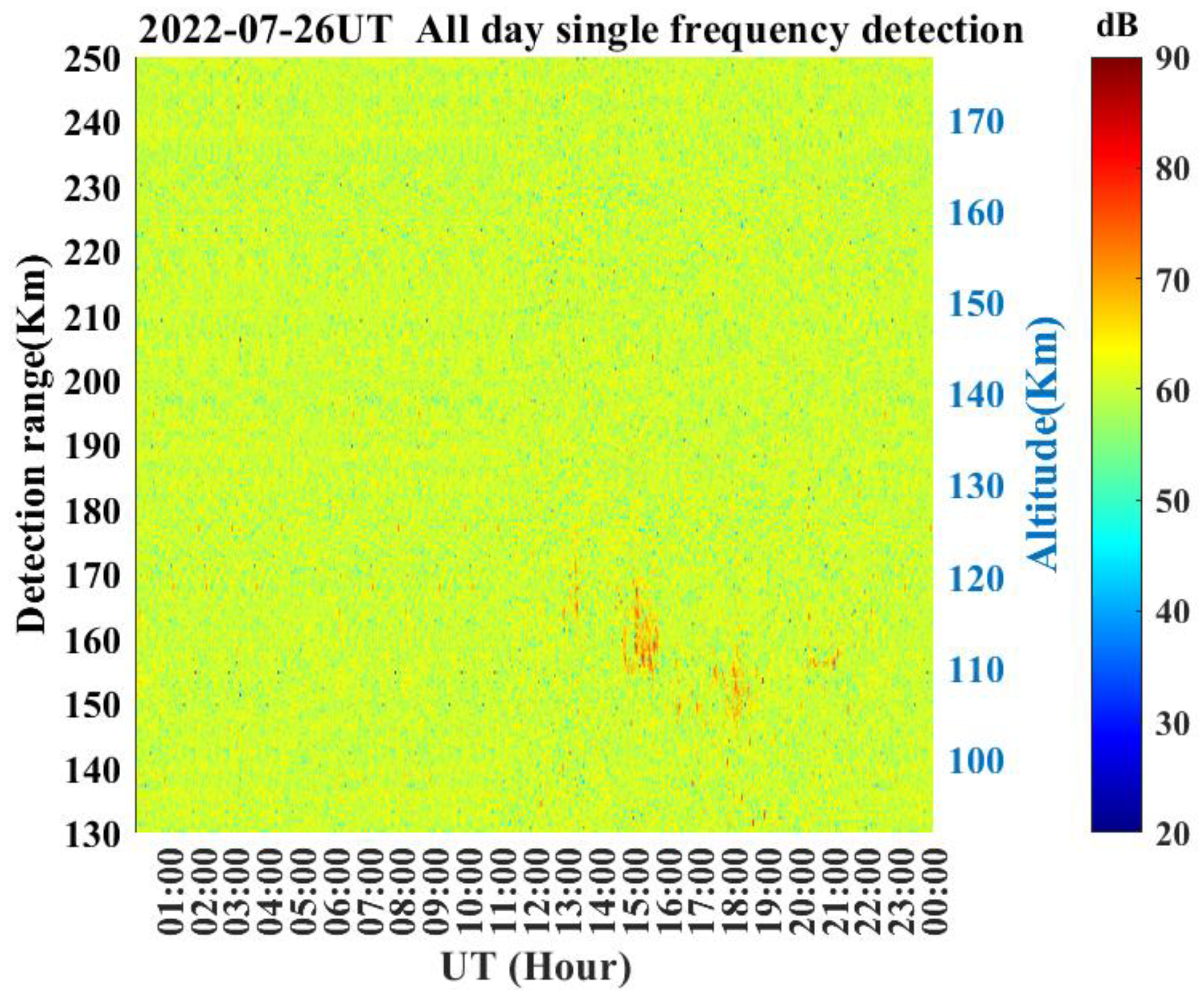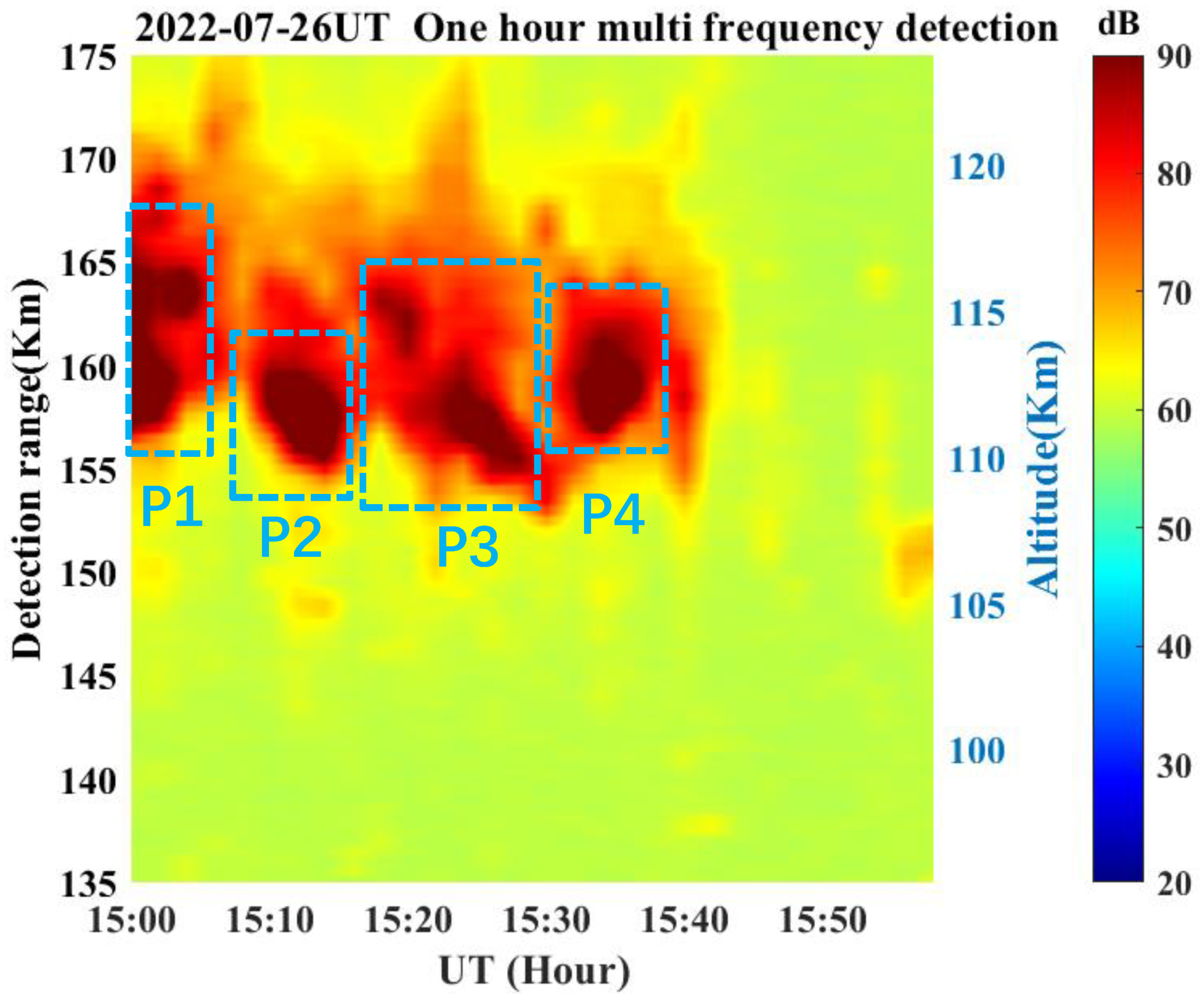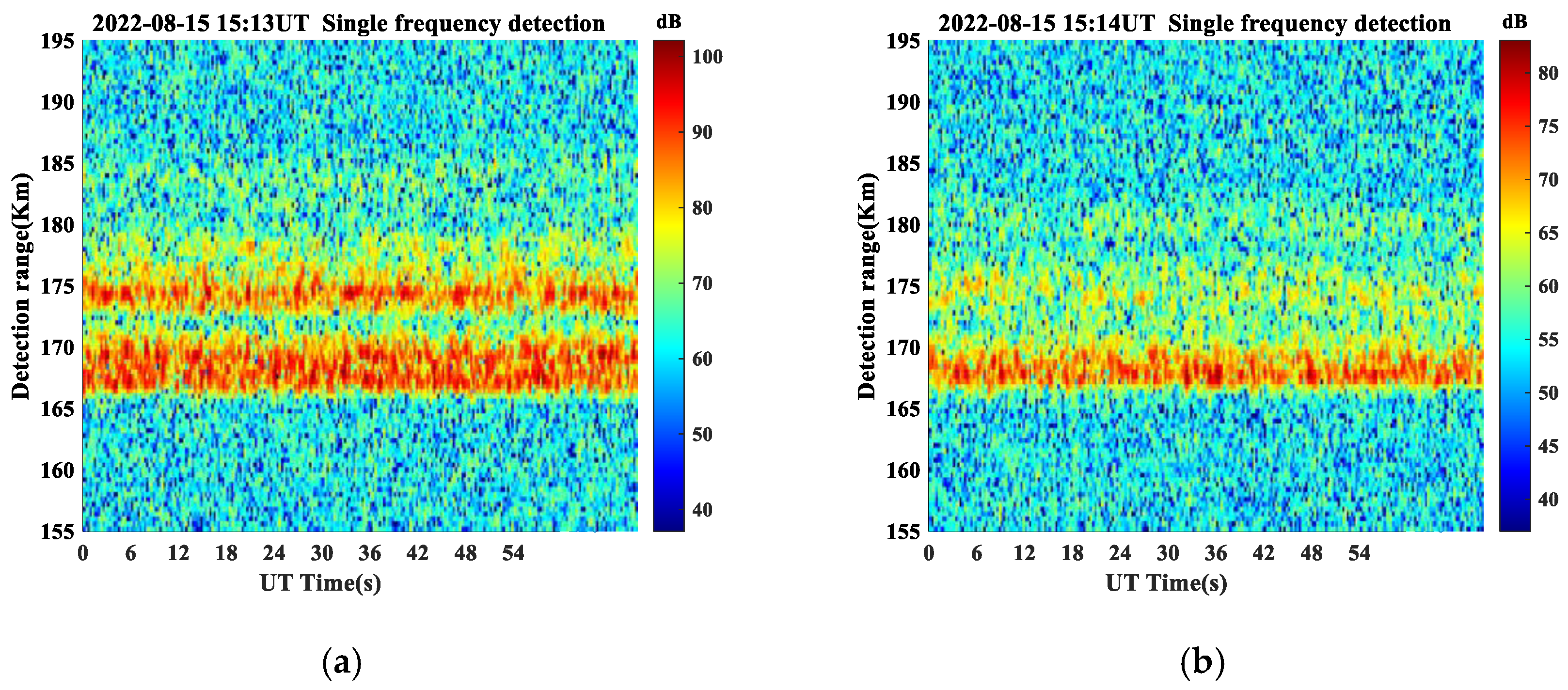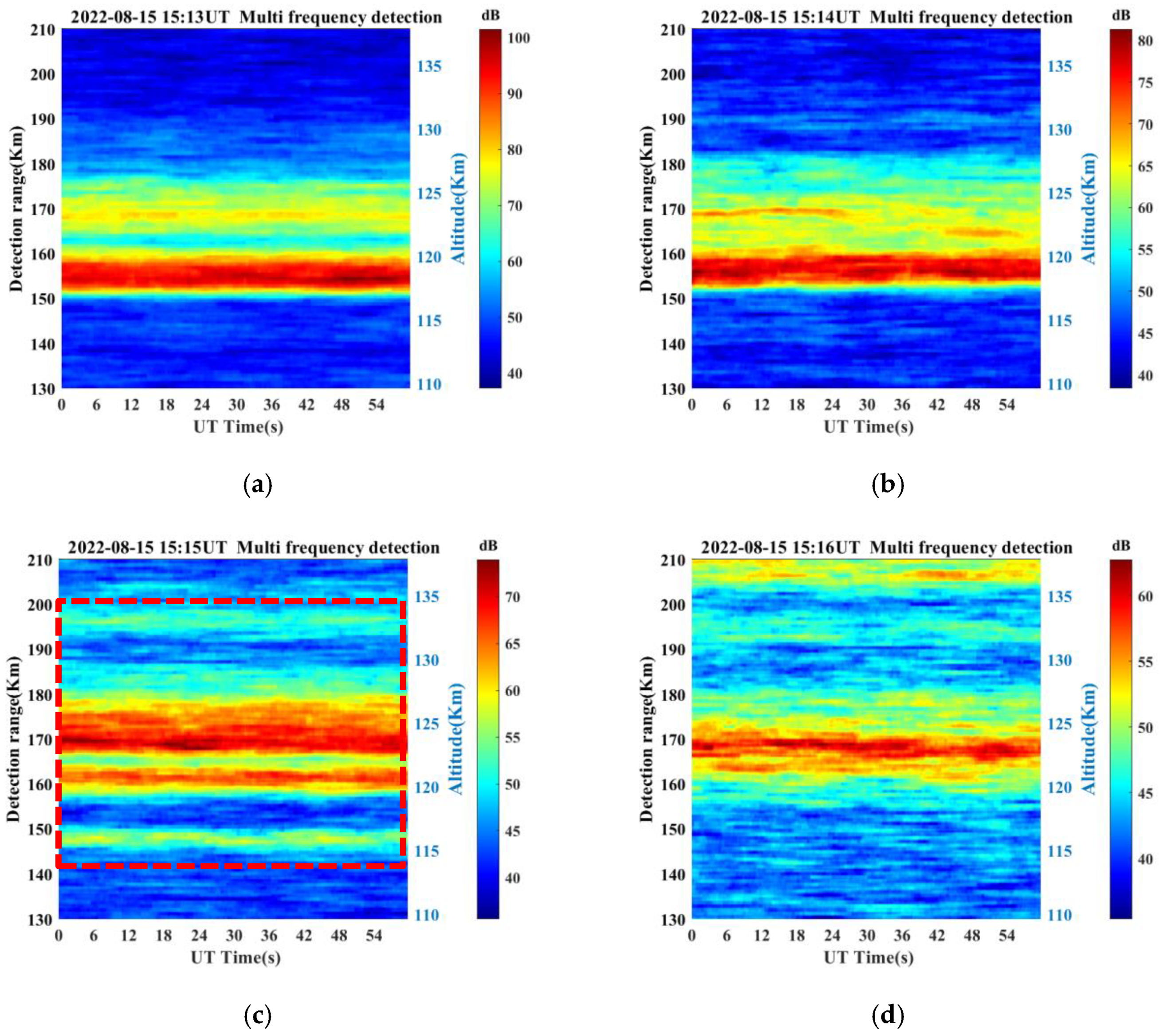High-Resolution Observation of Ionospheric E-Layer Irregularities Using Multi-Frequency Range Imaging Technology
Abstract
1. Introduction
2. Method
2.1. Multifrequency Range Imaging Algorithm
2.2. Equipment and Experimental Setup
3. Result
4. Discussion
5. Conclusions
Author Contributions
Funding
Data Availability Statement
Acknowledgments
Conflicts of Interest
References
- Booker, H.G. Turbulence in the ionosphere with applications to meteor trails. radio-star scintillation, auroral radar echoes, and other phenomena. J. Gephys. Res. 1956, 61, 673–705. [Google Scholar] [CrossRef]
- Ratcliffe, J.A. An Introduction to the Ionosphere and Magnetosphere; Cambridge University Press: Cambridge, UK, 1972. [Google Scholar]
- Balan, N.; Liu, L.; Le, H. A brief review of equatorial ionization anomaly and ionospheric irregularities. Earth Planet. Phys. 2018, 2, 257–275. [Google Scholar] [CrossRef]
- Yamamoto, M.; Fukao, S.; Ogawa, T.; Tsuda, K.; Kato, S. A morphological study on mid-latitude E-region field-aligned irregularities observed with the MU radar. J. Atmos. Sol. Terr. Phys. 1992, 54, 769–777. [Google Scholar] [CrossRef]
- Haldoupis, C.; Schlegel, K. Characteristic of midlatitude coherent backscatter from the ionospheric E region obtained with Sporadic E scatter experiment. J. Geophys. Res. 1996, 101, 13387–13397. [Google Scholar] [CrossRef]
- Fukao, S.; Yamamoto, M.; Tsunoda, R.T.; Hayakawa, H.; Mukai, T. The SEEK (Sporadic-E Experiment over Kyushu) Campaign. Geophys. Res. Lett. 1998, 25, 1761–1764. [Google Scholar] [CrossRef]
- Woodman, R.F.; Chau, J.L.; Aquino, F.; Rodriguez, R.R.; Flores, L.A. Low-latitude field-aligned irregularities observed in the E region with the Piura VHF radar, First results. Radio Sci. 1999, 34, 983–990. [Google Scholar] [CrossRef]
- Chau, J.L.; Woodman, R.F.; Flores, L.A. Statistical characteristics of low-latitude ionospheric field-aligned irregularities obtained with the Piura VHF radar. Ann. Geophys. 2002, 20, 1203–1212. [Google Scholar] [CrossRef]
- Patra, A.K.; Sripathi, S.; Sivakumar, V.; Rao, P.B. Statistical characteristics of VHF radar observations of low latitude E-region field-aligned irregularities over Gadanki. J. Atmos. Sol.-Terr. Phys. 2004, 66, 1615–1626. [Google Scholar] [CrossRef]
- Ning, B.; Hu, L.; Li, G.; Liu, L.; Wan, W. The first time observations of low-latitude ionospheric irregularities by VHF radar in Hainan. Sci. China Technol. Sci. 2012, 55, 1189–1197. [Google Scholar] [CrossRef]
- Li, G.Z.; Ning, B.Q.; Hu, L.; Li, M. Observations on the field-aligned irregularities using Sanya VHF radar, 2. Low latitude Ionospheric E-region quasi-periodic echoes in the East Asian sector. Chin. J. Geophys. 2013, 56, 2141–2151. (In Chinese) [Google Scholar]
- Li, G.Z.; Ning, B.Q.; Hu, L. Interferometry observations of low latitude E-region irregularity patches using the Sanya VHF radar. Sci. China Technol. Sci. 2014, 57, 1552–1561. [Google Scholar] [CrossRef]
- Wang, C.; Chu, Y.-H.; Su, C.; Kuong, R.; Chen, H.-C.; Yang, K. Statistical investigations of layer-type and clump-type plasma structures of 3-m field-aligned irregularities in nighttime sporadic E region made with Chung-Li VHF radar. J. Geophys. Res. 2011, 116, A12311. [Google Scholar] [CrossRef][Green Version]
- Zhou, C.; Liu, Y.; Tang, Q.; Gu, X.; Nin, B.; Zhao, Z. Investigation on the occurrence of mid-latitude E-region irregularity by Wuhan VHF radar and its relationship with sporadic E layer. IEEE Trans. Geosci. Remote Sens. 2018, 99, 7207–7216. [Google Scholar] [CrossRef]
- Tsunoda, R.T.; Buoncore, J.J.; Saito, A.; Kishimoto, T.; Fukao, S.; Yamamoto, M. First observations of quasi-periodic radar echoes from Stanford, California. Geophys. Res. Lett. 1999, 26, 995–998. [Google Scholar] [CrossRef]
- Aa, E.; Zou, S.; Liu, S. Statistical Analysis of Equatorial Plasma Irregularities Retrieved From Swarm 2013–2019 Observations. J.Geophys. Res. 2020, 125, e27022. [Google Scholar] [CrossRef]
- Liu, Y.; Zhou, C.; Xu, T.; Deng, Z.; Du, Z.; Lan, T.; Tang, Q.; Zhu, Y.; Wang, Z.; Zhao, Z. Geomagnetic and solar dependencies of midlatitude E-region irregularity occurrence rate, A climatology based on Wuhan VHF radar observations. J. Geophys. Res. Space Phys. 2022, 127, e2021JA029597. [Google Scholar] [CrossRef]
- Woodman, R.F.; Yamamoto, M.; Fukao, S. Gravity wave modulation of gradient drift instabilities in mid-latitude sporadic E irregularities. J. Geophys. Res. 1991, 18, 1197–1200. [Google Scholar]
- Tsunoda, R.T.; Fukao, S.; Yamamoto, M. On the origin of quasiperiodic radar backscatter from midlatitude sporadic E. Radio Sci. 1994, 29, 349–365. [Google Scholar] [CrossRef]
- Yokoyama, T.; Horinouchi, T.; Yamamoto, M.; Fukao, S. Modulation of the midlatitude ionospheric E region by atmospheric gravity waves through polarization electric field. J. Geophys. Res. 2004, 109, A12307. [Google Scholar] [CrossRef]
- Larsen, M.F. A shear instability seeding mechanism for quasiperiodic radar echoes. J. Geophys. Res. 2000, 105, 24931–24940. [Google Scholar] [CrossRef]
- Maruyama, T.; Fukao, S.; Yamamoto, M. A possible mechanism for echo striation generation of radar backscatter from midlatitude sporadic E. Radio Sci. 2000, 35, 1155–1164. [Google Scholar] [CrossRef]
- Bernhardt, P.A. The modulation of sporadic-E layers by Kelvin–Helmholtz billows in the neutral atmosphere. J. Atmos. Sol.-Terr. Phys. 2002, 64, 1487–1504. [Google Scholar] [CrossRef]
- Cosgrove, R.B.; Tsunoda, R.T. Simulation of the nonlinear evolution of the sporadic-E layer instability in the nighttime midlatitude ionosphere. J. Geophys. Res. 2003, 108, 1283. [Google Scholar] [CrossRef]
- Cosgrove, R.B.; Tsunoda, R.T. Instability of the E-F coupled nighttime midlatitude ionosphere. J. Geophys. Res. 2004, 109, A04305. [Google Scholar]
- Cosgrove, R.B.; Tsunoda, R.T.; Fukao, S.; Yamamoto, M. Coupling of the Perkins instability and the sporadic E layer instability derived rom physical arguments. J. Geophys. Res. 2004, 109, A06301. [Google Scholar]
- Liu, Y.; Zhou, C.; Tang, Q.; Kong, J.; Gu, X.D.; Ni, B.B.; Yao, Y.B.; Zhao, Z.Y. Evidence of mid- and low-latitude nighttime ionospheric E-F coupling, coordinated observations of sporadic E layers, F-region field aligned irregularities, and medium-scale traveling ionospheric disturbances. IEEE Trans. Geosci. Remote Sens. 2019, 57, 7547–7557. [Google Scholar] [CrossRef]
- Wu, J.; Zhou, C.; Wang, G.; Liu, Y.; Jiang, C.; Zhao, Z. Simulation of Es Layer Modulated by Nonlinear Kelvin Helmholtz Instability. J. Geophys. Res. Space Phys. 2021, 127, e2021JA030065. [Google Scholar] [CrossRef]
- Ecklund, W.L.; Carter, D.A.; Balsley, B. Gradient drift irregularities in mid-latitude sporadic E. J. Geophys. Res. 1981, 86, 858–862. [Google Scholar] [CrossRef]
- Yamamoto, M.; Fukao, S.; Woodman, R.F.; Ogawa, T.; Tsuda, T.; Kato, S. Midlatitude E region field-aligned irregularities observed with the MU radar. J. Geophys. Res. 1991, 96, 15943–15949. [Google Scholar] [CrossRef]
- Haldoupis, C.; Schlegel, K.; Farley, D.T. An explanation for type 1 radar echoes from the midlatitude E-region ionosphere. Geophys. Res. Lett. 1996, 23, 97–100. [Google Scholar] [CrossRef]
- Jin, H.; Zou, S.; Chen, G.; Yan, C.; Zhang, S.; Yang, G. Formation and Evolution of Low-Latitude F Region Field-Aligned Irregularities During the 7–8 September 2017 Storm, Hainan Coherent Scatter Phased Array Radar and Digisonde Observations. Space Weather 2018, 16, 648–659. [Google Scholar] [CrossRef]
- Jin, S.; Wang, Q.; Dardanelli, G. A Review on Multi-GNSS for Earth Observation and Emerging Applications. Remote Sens. 2022, 14, 3930. [Google Scholar] [CrossRef]
- Maruyama, T.; Saito, S.; Yamamoto, M.; Fukao, S. Simultaneous observation of sporadic E with a rapid-run ionosonde and VHF coherent backscatter radar. Ann. Geophys. 2006, 24, 153–162. [Google Scholar] [CrossRef]
- Chen, J.-S.; Zecha, M. Multiple-frequency range imaging using the OSWIN VHF radar, Phase calibration and first results. Radio Sci. 2009, 44, RS1010. [Google Scholar] [CrossRef]
- Chen, J.-S.; Chu, Y.-H.; Su, C.-L.; Hashiguchi, H.; Li, Y. Range imaging of E-region field-aligned irregularities by using a multifrequency technique, Validation and initial results. IEEE Trans. Geosci. Remote Sens. 2016, 54, 3739–3749. [Google Scholar] [CrossRef]
- Chen, J.-S.; Wang, C.-Y.; Chu, Y.-H.; Su, C.-L.; Hashiguchi, H. 3-D Radar Imaging of E-Region Field-Aligned Plasma Irregularities by Using Multireceiver and Multifrequency Techniques. IEEE Trans. Geosci. Remote Sens. 2018, 56, 5591–5599. [Google Scholar] [CrossRef]
- Chen, J.-S.; Wang, C.-Y.; Chu, Y.-H. Measurement of Aspect Angle of Field-Aligned Plasma Irregularities in Mid-Latitude E Region Using VHF Atmospheric Radar Imaging and Interferometry Techniques. Remote Sens. 2022, 14, 611. [Google Scholar] [CrossRef]
- Palmer, R.D.; Yu, T.Y.; Chilson, P.B. Range imaging using frequency diversity. Radio Sci. 1999, 34, 1485–1496. [Google Scholar] [CrossRef]
- Yu, T.Y.; Palmer, R.D. Atmospheric radar imaging using multiple-receiver and multiple-frequency techniques. Radio Sci. 2001, 36, 1493–1503. [Google Scholar] [CrossRef]
- Capon, J. High-resolution frequency-wavenumber spectrum analysis. Proc. IEEE 1969, 57, 1408–1418. [Google Scholar] [CrossRef]
- Luce, H.; Hassenpflug, G.; Yamamoto, M.; Fukao, S. High-resolution vertical imaging of the troposphere and lower stratosphere using the new MU radar system. Ann. Geophys. 2006, 24, 791–804. [Google Scholar] [CrossRef][Green Version]
- Ning, B.; Li, Z.; Hu, L.L.M. Observations on the field-aligned irregularities using Sanya VHF radar, 1. Ionospheric E-region continuous echoes. Chin. J. Geophys. 2013, 56, 719–730. (In Chinese) [Google Scholar]
- Zhang, S.; Zhao, Z.; Zhou, C.; Ni, B.G.X. Wuhan VHF coherent scattering radar and its initial observation results. Mod. Electron. Tech. 2016, 39, 1–5. [Google Scholar]
- Earle, G.D.; Bishop, R.L.; Collins, S.C.; Gonzalez, S.A.; Sulzer, M.P. Descending layer variability over Arecibo. J. Geophys. Res. 2000, 105, 24951–24961. [Google Scholar] [CrossRef]
- Mathews, J.D. Sporadic E, Current views and recent progress. J. Atmos. Sol. Terr. Phys. 1998, 60, 413–435. [Google Scholar] [CrossRef]
- Szuszczewicz, E.P.; Roble, R.G.; Wilkinson, P.J.; Hanbaba, R. Coupling mechanisms in the lower ionospheric-thermospheric system and manifestations in the formation and dynamics of intermediate and descending layers. J. Atmos. Terr. Phys. 1995, 57, 1483–1496. [Google Scholar] [CrossRef]
- Zhu, Y.; Tang, Q.; Deng, Z.; Zhou, C.; Liu, Y.; Xu, T.; Wang, Z.; Zhao, Z.; Wei, F.; Feng, X. The study of daytime ionospheric E-region radar echoes simultaneously observed by Qujing VHF radar and multi-ionosondes. Space Weather 2022, 20, e2021SW002998. [Google Scholar] [CrossRef]









| System | VHF Pulse Doppler Radar |
|---|---|
| Center frequency | 48.2 MHz |
| Antenna | 1 sending and 24 receiving |
| Transmitter | Peak power: 20 Kw |
| Receiver | 6 Digital channel receiving system |
| Peripherals | 24 antennas for layer E FAI observation |
| Parameter | Numerical Value |
|---|---|
| Observation site | (114.2°E, 30.3°N) |
| Observation time | From 15 July 2022 to now |
| Distance range | 130 km–250 km |
| Original range resolution | 500 m |
| Time resolution | 1 min |
| Pulse repetition rate | 550 Hz |
| Coherent accumulation times | 8 |
| Coding system | 16 bit complementary code |
| Transmission signal bandwidth | 320 kHz |
| Carrier frequency (MHz) | 48.15, 48.16, 48.17, 48.18, 48.19 48.20, 48.21, 48.22, 48.23, 48.24, 48.25 |
Disclaimer/Publisher’s Note: The statements, opinions and data contained in all publications are solely those of the individual author(s) and contributor(s) and not of MDPI and/or the editor(s). MDPI and/or the editor(s) disclaim responsibility for any injury to people or property resulting from any ideas, methods, instructions or products referred to in the content. |
© 2023 by the authors. Licensee MDPI, Basel, Switzerland. This article is an open access article distributed under the terms and conditions of the Creative Commons Attribution (CC BY) license (https://creativecommons.org/licenses/by/4.0/).
Share and Cite
Chen, B.; Liu, Y.; Feng, J.; Zhang, Y.; Zhou, Y.; Zhou, C.; Zhao, Z. High-Resolution Observation of Ionospheric E-Layer Irregularities Using Multi-Frequency Range Imaging Technology. Remote Sens. 2023, 15, 285. https://doi.org/10.3390/rs15010285
Chen B, Liu Y, Feng J, Zhang Y, Zhou Y, Zhou C, Zhao Z. High-Resolution Observation of Ionospheric E-Layer Irregularities Using Multi-Frequency Range Imaging Technology. Remote Sensing. 2023; 15(1):285. https://doi.org/10.3390/rs15010285
Chicago/Turabian StyleChen, Bo, Yi Liu, Jian Feng, Yuqiang Zhang, Yufeng Zhou, Chen Zhou, and Zhengyu Zhao. 2023. "High-Resolution Observation of Ionospheric E-Layer Irregularities Using Multi-Frequency Range Imaging Technology" Remote Sensing 15, no. 1: 285. https://doi.org/10.3390/rs15010285
APA StyleChen, B., Liu, Y., Feng, J., Zhang, Y., Zhou, Y., Zhou, C., & Zhao, Z. (2023). High-Resolution Observation of Ionospheric E-Layer Irregularities Using Multi-Frequency Range Imaging Technology. Remote Sensing, 15(1), 285. https://doi.org/10.3390/rs15010285








